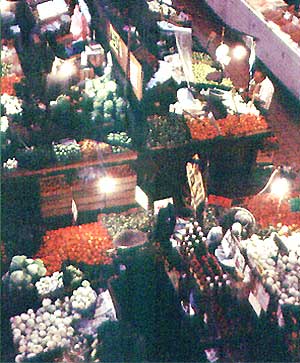

In Mexico the 1800s constituted a period of almost uninterrupted political upheaval and economic chaos, beginning with the War of Independence against Spain in 1810. In quick succession came the insurrection against the "empire" of Iturbide, the loss of Texas to the United States, war with that country, a civil war, and a war against European intervention. Between Independence and the dictatorship of Porfirio Días, which began in 1876, Mexicans saw more than seventy chiefs of state. With only one or two exceptions, each successive government was bankrupt and corrupt.
During the 1800s, mining and textile manufacturing were among the industries that collapsed. As Mexican politics decayed into general anarchy, roads connecting markets became vulnerable to assault. Itinerant merchants were obliged to travel in groups for mutual protection. These conditions profoundly changed the mix of products available in mercados. Availability of manufactured items and exotic goods diminished drastically.
However, in impoverished villages up in the mountains, the same hard times favored the resurgence of cottage industries. Gone from the markets were the finely woven textiles from big cities, so locally produced fabric, made by hand or simple looms, once again came into demand. The major trade routes lost their mule trains and wagonloads of goods, but humble campesinos with a few goods on their backs could usually pass unmolested on their narrow, muddy footpaths or trails, to or from nearby markets.
Men carrying goods on their backs, especially handcrafted items such as pottery, serapes, wooden tools, and eating implements, were much in use at this time. A man with a backload of goods could hike from Colima to Morelia -- a straight-line distance through rough mountains of 180 miles -- in six days. A man might carry handcrafted goods from his mountain home to a coastal city, sell them, buy manufactured items such as fine cloth, alcohol, or machetes, lug them back into the highlands, and mark up the price some 400%.
In 1876, dictator Porfirio Díaz took over the Mexican government, restored public order, encouraged foreign investment, and improved Mexico's network of communication. Railroads were established, the mining industry experienced a rebirth, major commercial centers grew and thrived, and once again the big landowners, or latifundistas, found conditions ripe for expansion. While during anarchic times the big landowners' success had rested on producing many basic essentials for self sufficiency, now it became advantageous for them to intensely cultivate huge plantations of tobacco, sugarcane, and rice. The average poor Mexican now found himself in debt to one latifundista or another, having to work very long hours on the plantations and never really getting ahead.
Once again exotic and manufactured goods became commercially available, but how could the ever-more impoverished typical Mexican buy them? Two parallel economies developed: One economy was exemplified by trainloads of tobacco and sugarcane heading to a commercial center to be processed by industry, and possibly to be exported; the other economy was epitomize by the dirt-poor Mexican leading his burro to market in the next town, to sell his goods at a pittance, to folks who could seldom afford paying more than an pittance.
With the end of Porfirio Días's dictatorship in 1910, another twenty years of chaos ensued, for these were the years of Pancho Villa. Bands of bandits, or soldiers behaving like bandits, looted and burned one town after another; innumerable head of livestock were stolen or killed, and very many campesinos yielded their lives on behalf of one faction leader or another. Nonetheless, somehow mercado life continued, always with buyer and seller looking over their shoulders.
From the early 1930's to the present, relative tranquility and stability returned to Mexico. Commercial centers and traditional mercados alike have flourished, and in much of Mexico, particularly in the southern highlands, Indian artisans continue producing worthy handicraft. Today many Mexican cities are home to both thriving mercados and large department stores and chain stores, such as K-Mart, Sams, and the Mexican Gigante chain.
From our mercado perspective, two features of recent Mexican demographic history are especially important. First, it is hard to find anyone in Mexico who does not have a close family member or friend who is or has been working in the United States. These workers send a flood of dollars into Mexico's most remote regions, to an amazing extent helping fuel local mercado economies. On the other hand, invariably, when these workers return home, they bring with them hankerings for toasters and satellite dishes, and maybe a little disdain for the mercado's sweet potatoes and locally produced handicraft.
Another feature of recent Mexican demographic history important to consider here is the mass movement of people, especially young ones, from the countryside into the cities. A family of eight in Tamazunchale, San Luis Potosí is fairly typical. During the children's formative years the family was desperately poor, but somehow they scraped along, often with help from relatives and friends.
Today the children range in ages from fifteen to thirty. The three sons have all moved from Tamazunchale, in the Gulf lowlands, to Mexico City, in the highlands. Each regularly sends a little money home. Today the family still is mostly unemployed, and still resides on a crowded, slummy slope with no roads, and rather informal and unpredictable plumbing and electrical connections. However, they have added cement-block rooms to their house, inside the kitchen there stands a second-hand blender, and atop the house there resides a satellite dish.
And, yet, despite the blender and the satellite dish, the family still buys its tortillas from the tortillaría next to the mercado, and fruit, vegetables, and beans from the mercado itself.